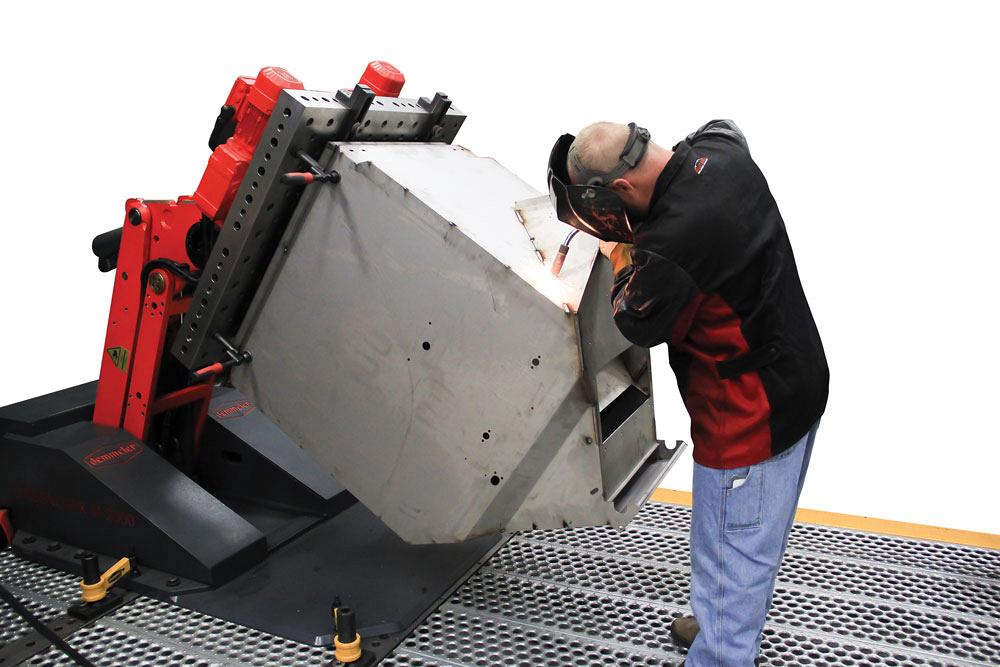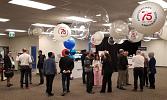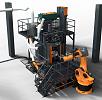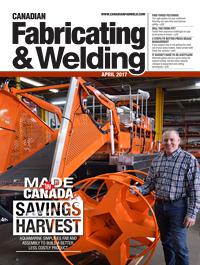- FMA
- The Fabricator
- FABTECH
- Canadian Metalworking
Fine-tuned fixturing
Finding the right solution for your weldment fixturing can save you time and improve the safety of your shop
- By Brian Dodsworth
- April 18, 2017
- Article
- Welding

: A single-spine manual trunnion design rollover system gives the operator clear access to more of the part while still providing six points of contact for locating and securing the part in place.
Fixturing systems for welding can save operators a lot of time while improving the quality of the finished weld and creating a safer working environment. If that fixturing system can also be rolled over such that it is unnecessary to manually turn a part over, safety and accuracy can be improved too.
The challenge is determining what kind of fixturing system suits your needs. Most shops try to get the most out of their fixtures without adding too much cost to the bottom line. There really is a solution for any budget, of course. It’s a matter of determining when the extra expense of a piece of equipment equals or is less than the amount of savings gained from speed and safety improvements.
Manual Trunnion Rollover Systems
Fixturing systems that allow parts to be rotated in place are gaining in popularity. A lot of shops still flip parts by hand, but doing it this way can be time-consuming and raises health and safety concerns. Often the parts being flipped manually are between 200 and 1,000 lbs.; the part isn’t heavy enough to seem to warrant an automated fixturing system, but it is undeniably awkward to shift.
To solve this problem, many shops build their own picture frame-style rollover system, which is a simple rectangular frame made with square tube on which a part can be clamped. While this is a cost-effective method in some ways, it also requires build time, and the frames may not be as rigid and precise as parts require.
Although picture frame-style rollover systems are right for some applications, shops might also consider a single-spine design. A single-spine design gives the operator clear access to more of the part while still providing six points of contact for locating and securing the part in place. The setup still accommodates many different sizes and shapes of parts, and there is no outer frame to make access to certain areas of the part difficult.
The use of a single-spine system does require somewhat more planning, but that should also lead to more accurate welds and safer operation. For instance, with a single-spine manual rollover system, it is important to know the part’s centre of gravity so that it is well-balanced on the fixture. This is necessary for releasing the lock on the fixture. When it is well-balanced, the part won’t start to spin. This is very easy to manage with the use of CAD.
Working through fixturing in CAD also helps you work through precisely what you can expect from a fixture. Sometimes, until you see a part on a fixture, it is hard to visualize the types of access challenges you might face. It can also help clarify whether all of your parts can be run through on one rollover system, or if you need multiple systems to accommodate a range of parts.
A manual rollover fixture of this kind has its limitations, of course. The single-beam setup tends to work best with parts less than 10 ft. long. Beyond that, rigidity and overall flatness could potentially be an issue.
Also, a manual rollover fixture is best-suited to flat parts – frames and support structural parts, and tube structures without much depth. When you start considering sheet metal boxes, using this type of fixture has some value, but as the height of the box increases, this type of fixture doesn’t support the part as well. Calculating the centre of gravity becomes trickier and your access to the part is affected.

Larger box-type structures are better served by a multi-axis positioner. This gives you fine control, allowing you to tilt, rotate, and spin the part at the same time.
Powered Manipulators
Larger box-type structures are better served by a multi-axis positioner. Because this type of system is automated, the price rises substantially because of the need for hydraulics, motors, and a control unit. However, this does give you fine control, allowing you to tilt, rotate, and spin the part at the same time. In some cases, these positioners can tilt to a full 180-degree upside-down position, if the part allows for it. For a welder this can be a huge advantage because he or she never has to weld in an ergonomically awkward setup.
The other benefit to a modular manipulator of this kind is that you have the ability to fixture a number of different parts without having to figure out tooling every time. It allows you to do more complex parts because they can be held in more ways than if you were to simply clamp them to a flat surface.
Again, preparing to use a powered positioner/manipulator requires careful planning through the use of CAD. These machines have a load curve that considers the weight of the part and how far off the base plate it stands. The cost of powered manipulators should not be quickly dismissed as too expensive. With a detailed time study, you may find these systems to be more cost-effective than you realize.
Steady Rest Rollovers
There is another category of rollover system that is useful for very long parts. These heavy-duty rollover systems, based on multiple steady rest bases, are designed for parts that are 15 to 20 ft. long or more. This is an effective method for companies that build products like booms for multi-purpose utility trucks. They can be designed such that two or more support modules are along the length of the fixture. As a manual system it remains cost-effective, although overall length is the primary driver of the final cost. The wheels in the steady rest bases may turn on something as simple as V-groove bearings; however, a powered, variable-speed motor can be added.
Manually turning over awkward parts can be hazardous and time-consuming. Rotating fixtures can save man-hours and improve turnaround time on parts. Right-sizing the system for your shop is the biggest challenge, but worth the time spent.
Brian Dodsworth is engineering manager at Bluco Corp., 800-535-0135, www.bluco.com.About the Author
subscribe now


Keep up to date with the latest news, events, and technology for all things metal from our pair of monthly magazines written specifically for Canadian manufacturers!
Start Your Free Subscription- Trending Articles
FMA Annual Meeting: Ingenuity still key with tech innovations

Messer Canada hosts anniversary event

Welding jacket designed for protection, comfort

Compact swing chamber shot blast machine features robotic workpiece handling

Gang punching press system accommodates different parts quickly

- Industry Events
MME Saskatoon
- May 28, 2024
- Saskatoon, SK Canada
CME's Health & Safety Symposium for Manufacturers
- May 29, 2024
- Mississauga, ON Canada
DiPaolo Machine Tools Open House 2024
- June 4 - 5, 2024
- Mississauga, ON Canada
FABTECH Canada
- June 11 - 13, 2024
- Toronto, ON Canada
Zoller Open House & Technology Days 2024
- June 12 - 13, 2024
- Ann Arbor, MI
















